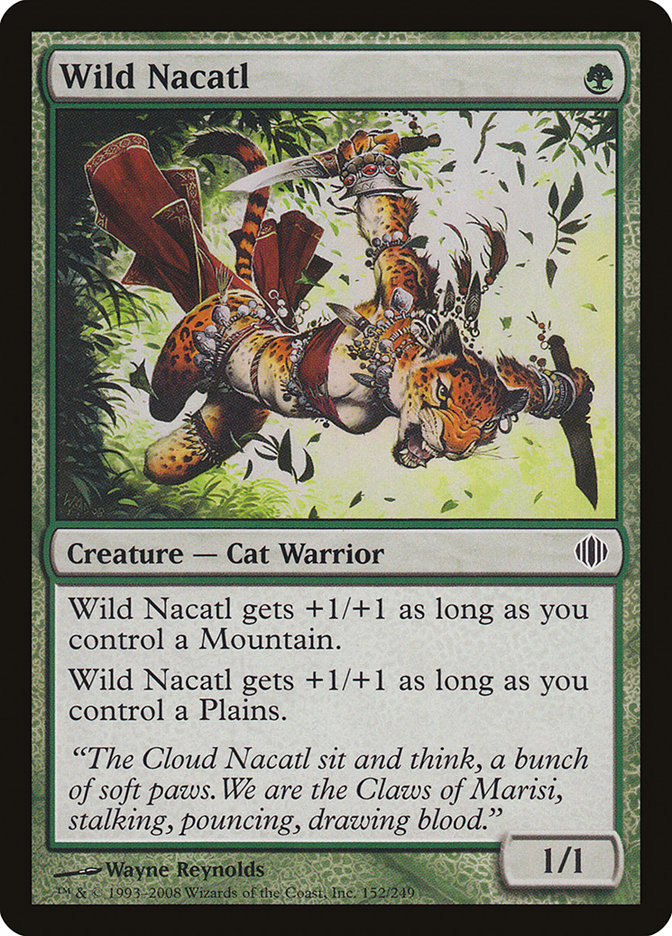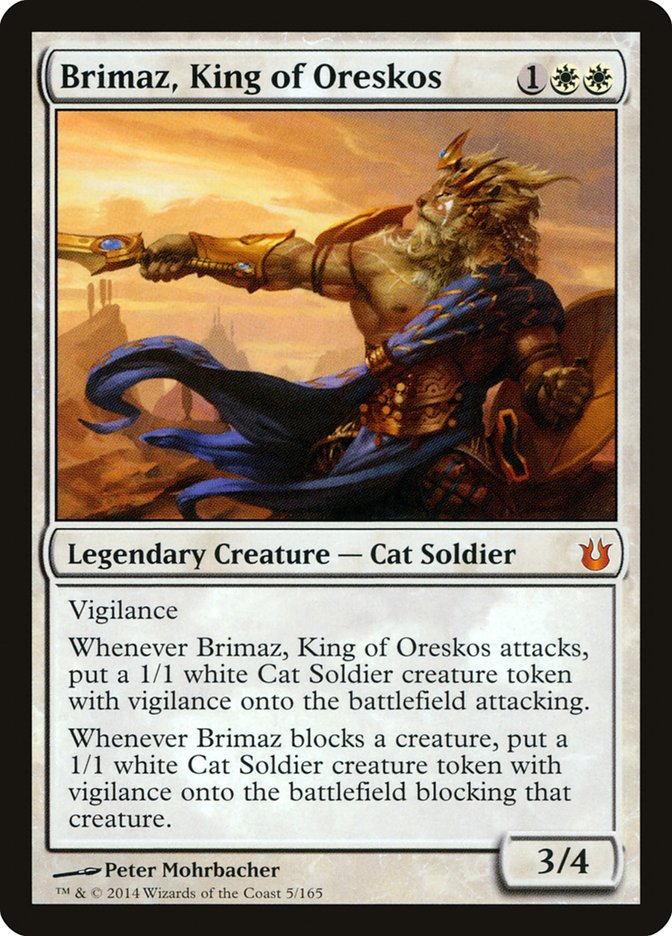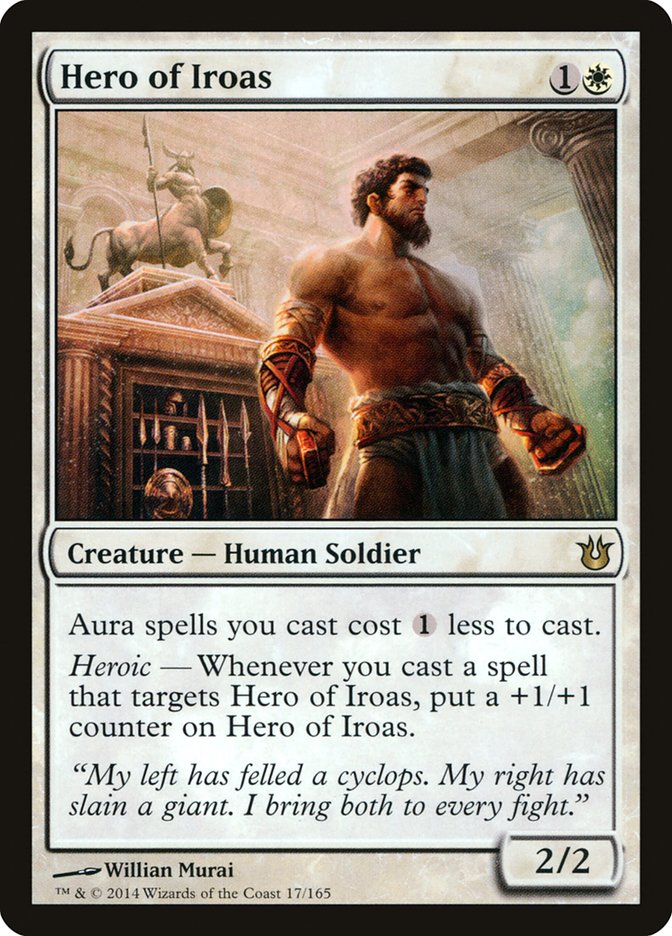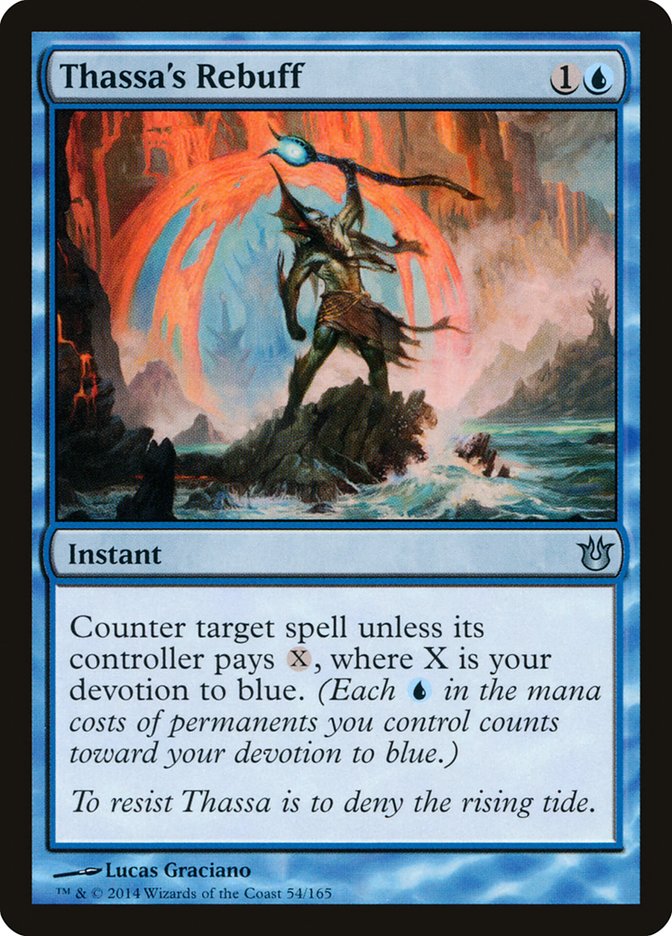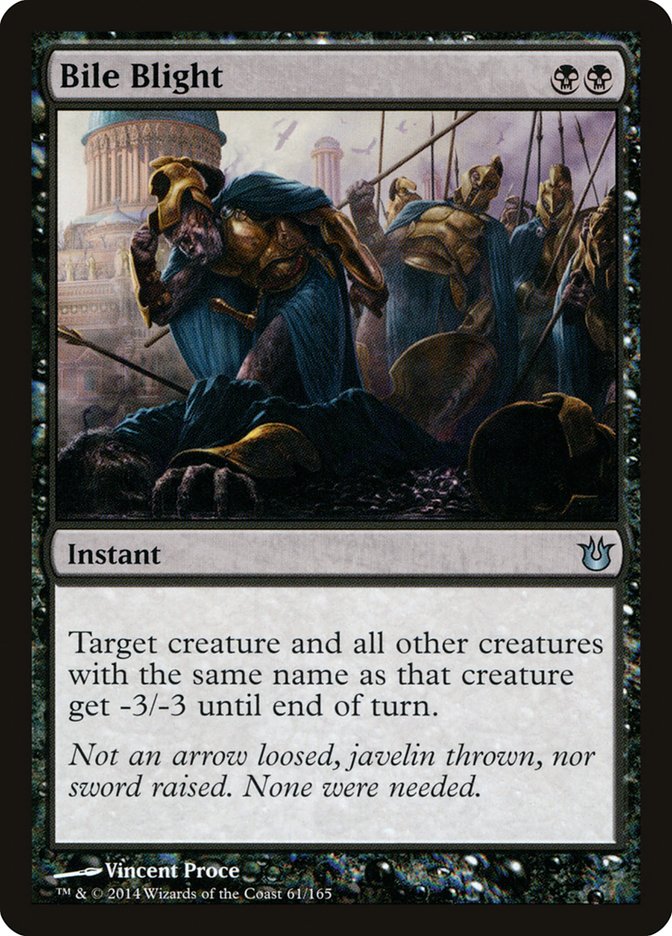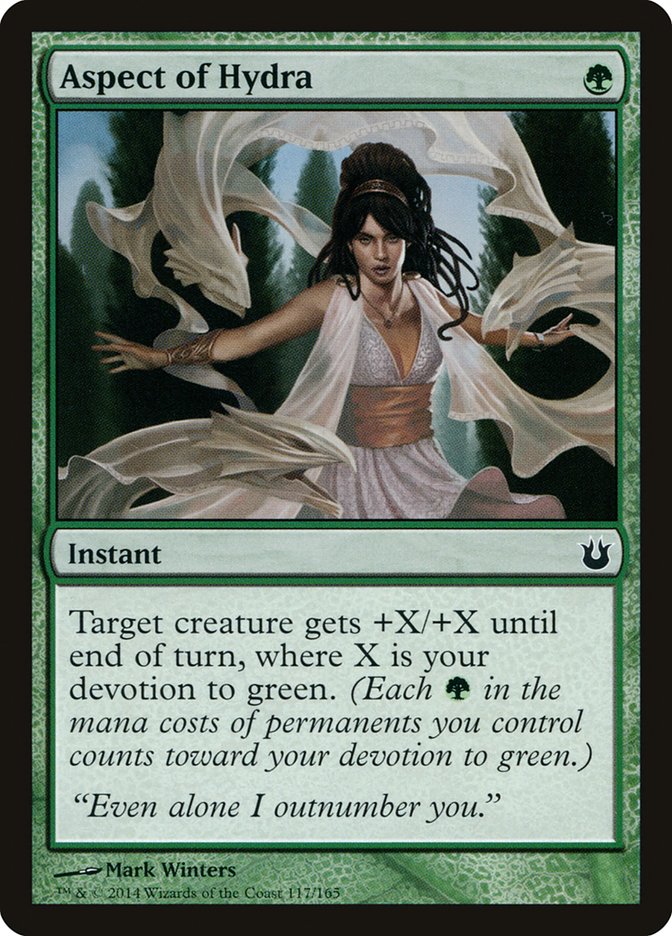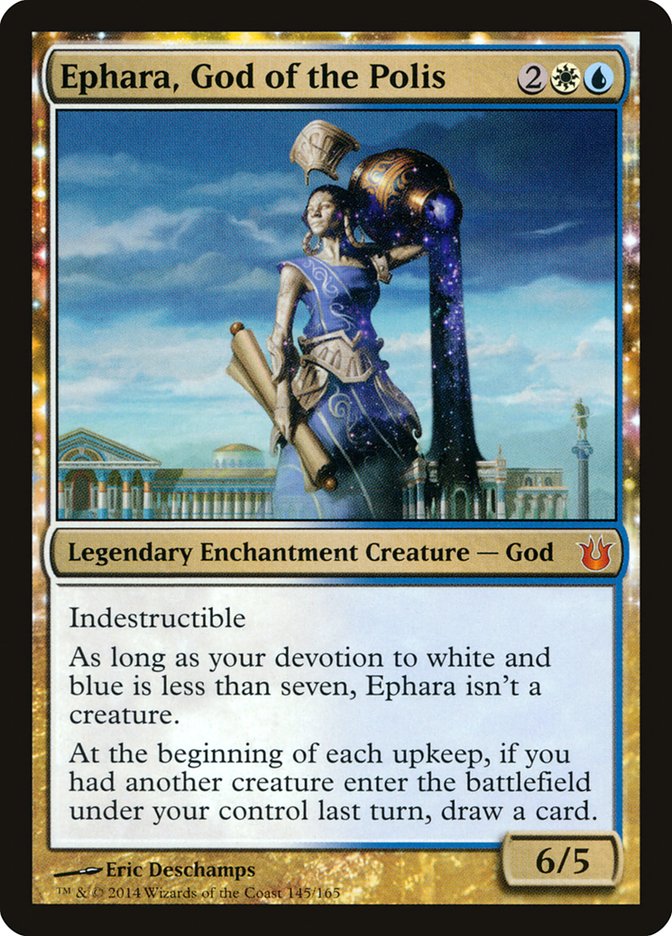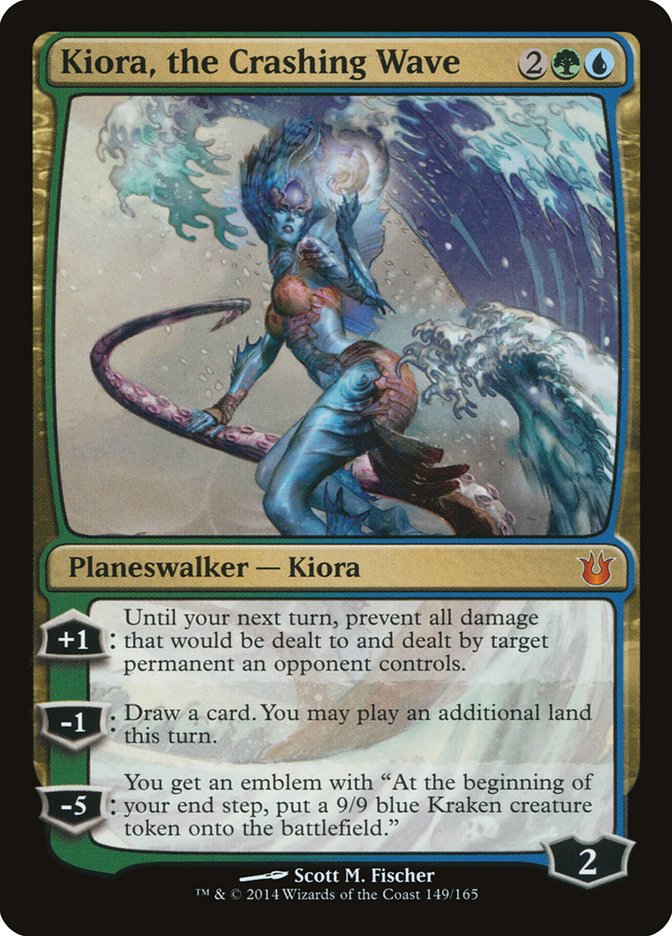I woke up Monday morning like I do every morning: to a standard yet awesome bacon and eggs breakfast, some ESPN, and a little bit of browsing and deckbuilding. I knew something had happened at midnight by the massive amounts of Facebook private message notifications that I never answer anyway, but I saw for myself:
Deathrite Shaman is banned.
Wild Nacatl and Bitterblossom are unbanned.
I didn’t really put much emotional reaction to the announcement. It’s not really what I do. I continued eating my breakfast and went to work.
If you read my article last week, I put a ton of emphasis on how much the numbers two and four matter in the format. Well, continuing with that macro analysis, the theory is even more reinforced now. Not only do we have an extremely direct example of this theory in Bitterblossom, but we have the same Delver of Secrets example that was given last week in Wild Nacatl, where it functions as a catalyst for your entire supporting cast and will continue to do so until something is done about it in the game.
This puts a lot more emphasis on how one looks at the four slot as well, mostly due to how much more important it is to follow up after dealing with the much denser early game. Dealing with a Wild Nacatl or Bitterblossom is great and all, but if you aren’t doing anything afterward, then you’re just going to die to everything else anyway.
Unfortunately, there’s way too much of a knee-jerk reaction to the announcement, so it’s very difficult to find rational information right now. Now Faeries is the best deck in the format, midrange is dead, Volcanic Fallout is a $75 uncommon, and the country is freezing over.
Let’s not be ridiculous . . .
Those that are rejoicing over the apparent death knell of midrange are going to be in for a really rude awakening when they get grinded into the ground by Liliana of the Veil, Scavenging Ooze, and the rest of the same shell that was kicking butt before the banning. While Deathrite Shaman is an immense loss to midrange decks, midrange will never ever die as long as there are efficient permanents that perform well on multiple offensive and defensive angles.
As far as the overall shape of the format, it definitely changes a bit, but not as much as people may think. There’s much more of a cascading effect on the format than a linear one. Yes, there are clear winners and losers, but are they winners directly because of the changes or because of the hype around the changes? This is very similar to metagaming 101 and is not talked about enough.
A Closer Look
Let’s take a look at the most talked about topic thus far: Faeries. How do you build a Faeries deck to beat what’s happening right now?
Put simply, you can’t.
You are just another deck, just like every deck in Modern. You can’t prey on the smaller card pool that you had in Standard and Extended. No deck in Modern can do that. You’re on the same playing field as decks straight-up killing you over and under a Bitterblossom. You’re casting a Mistbind Clique on a board full of mana dorks that will just Birthing Pod you to death. Your Faerie friends have never heard of Abrupt Decay, and your Merfolk rivals are way stronger than they were the first time around and will run you over if you think you can just breeze by them like you did a few years ago.
You’re going to be a deck. There’s no doubt about that. There’s a very good shot that you’re going to be a good deck. Bitterblossom is not even close to the whole story though. In fact, I think that the success of Faeries will be solely dependent on the preparation by those playing in the Pro Tour.
It’s a bit of a shame really because Bitterblossom can shine in so many more places outside of Fae (and probably be more potent), but unless something busted happens in Valencia, it’s very unlikely we’ll get the chance to see that early on.
Besides, Delver of Secrets has been playing the Fae game since the format started.
We can do so much more than we’re doing now. Adrian Sullivan got the ball rolling with a not-Faeries Bitterblossom deck, and if we’re going to find out its maximum potential, then we have to aggressively look for powerful themes and subthemes with cards printed after it was usable in a non-Legacy Eternal format.
Creatures (11)
Lands (23)
Spells (26)

This is an example of how to maximize Bitterblossom itself and is the role I see the card taking in Modern. Simply having a deck with Bitterblossom in it is just not good enough, and you want ways of pushing the race in your favor past just mere 1/1 fliers. Intangible Virtue, Auriok Champion, and Hero of Bladehold are good ways of doing this and make actual game winners out of your Faerie Rogues.
If you’re going to go with a plan, go all the way. Bitterblossom is a great test to see who is willing to do this, and it’ll be interesting to see how far we can go with it in Modern.
On the other side of the spectrum, we have Wild Nacatl.
Wild Nacatl was initially banned because of how restrictive aggressive decks would be with it around. Essentially any aggro deck that didn’t have Wild Nacatl should have just had Wild Nacatl in it, and that isn’t what they wanted in the format. Unfortunately, aggressive decks were few and far between, with Affinity being the king of them all. Wild Nacatl adds some really high power to the Zoo decks that have fallen out of favor as of late, but I have the same problem with the reaction to Wild Nacatl as I do with Bitterblossom.
Why are we only looking at Zoo decks?
Creatures (22)
Lands (18)
Spells (20)

Again, not the most optimal shell, but it serves as an example of how you can push the boundaries of what you can do with the tools you have access to. We’ve played a Zoo game with Delver of Secrets before, but playing a Delver game with Wild Nacatl is now a real thing. Plus you gain access to the incredible reach of Tribal Flames and (secretly just as much reach) Vapor Snag.
New Additions
Born of the Gods brings more new tools to the table than even I initially thought, and it’s rather scary how much potential some of them have. While I don’t think that there are any cards that really create a brand-new archetype, there are plenty of cards that can support existing ones.
I hinted at Brimaz, King of Oreskos a little bit in the W/B/R deck’s sideboard, and in a format where efficiency is everything, Brimaz is one of the best creatures to have. I don’t think that it’s necessarily better than Hero of Bladehold, not really because of things like Abrupt Decay but more because of how cross-applicable they are with each other. Using the Abrupt Decay example, we can easily make Decay very awkward for our opponent by sideboarding Brimaz out for Hero, making Decay worse, or by boarding it in with Hero in a deck that Abrupt Decay isn’t good against in the first place (and subsequently boarding it back out after game 2).
Regardless, being able to defend very well against early Tarmogoyfs, Geist of Saint Trafts, and Wild Nacatls while still attacking through said Wild Nacatls and Etched Champions is not something to be taken lightly. Mufasa can end games very quickly, and I wouldn’t be surprised to see it with some regularity in all sorts of decks.
The obvious place for Hero of Iroas is in the Slippery Bogle deck, but its effectiveness is solely dependent on how many Auras you’re playing that have a colorless in its cost. Currently there aren’t too many to choose from, but I can see boarding this in against decks that aren’t looking to interact with you very much. This may have to wait a bit until a cheaper Aura/bestow creature becomes available to complement Kor Spiritdancer.
Merfolk usually has two to four flex slots in its 75, and Unified Will was always a solid option. Thassa’s Rebuff is a nice cross-grade from Unified Will in that you can play it against other creature decks and still be fine. Unified Will is much better at handling combo decks like Splinter Twin, but that’s something you have to weigh when choosing a tool for a job.
Another premier removal spell for the Modern format. If you think Bile Blight is insane in Standard, it’s probably even better in Modern. It’s pretty awesome that this card handles both Bitterblossom and Wild Nacatl in a pinch as well as kills infinite Pestermites, buying you a turn against infinite Deceiver Exarchs, early Tarmogoyfs, almost every creature in Zoo, plenty of assorted tribal creatures, and tokens made from Wurmcoil Engine. The bigger aggressive decks become, the more important this card will be.
I could see Mono-Green Devotion decks utilizing this as a way to push through a ridiculous amount of damage when the Genesis Wave plan doesn’t come together. I could also see R/G Blitz incorporate this into its plan.
I firmly believe that Ephara, God of the Polis will see Modern play. It may not be now and may not even be this season, but it’s easily the most powerful God in the set for Modern. The flash decks of last season were already great at generating an advantage that Ephara can capitalize off of, so why not?
Creatures (25)
- 2 Aven Mindcensor
- 4 Spellstutter Sprite
- 3 Vendilion Clique
- 3 Plumeveil
- 4 Snapcaster Mage
- 3 Geist of Saint Traft
- 4 Restoration Angel
- 2 Ephara, God of the Polis
Lands (24)
Spells (11)

You can very easily keep the engine going by drawing two cards a turn and then translate those cards into devotion, which then translates into damage! Ephara could also work in a more traditional control deck, making its best Phyrexian Arena impression until it’s ready to kill your opponent (and does so very fast).
The first thing I thought when I saw Kiora, the Crashing Wave was Scapeshift. I love how it handles very large singular threats that slip through the Remand / Cryptic Command cracks, and Scapeshift would love to have a secondary win condition in Kiora’s ultimate, which is fairly quick for a planeswalker ultimate. Even getting an Explore out of her isn’t the worst thing in the world, and getting her down on turn 3 is a real sweet spot in Modern, locking down the important twos while getting under the pivot fours.
For Better Or For Worse
Summing all of this up, here is what I think are the big changes in Modern considering the combination of Born of the Gods and the new banning and unbannings:
What Gets Better
- Green-based aggressive decks. As previously talked about, you should expect to see way more aggro decks with Wild Nacatl in them from this point forward (regardless of if they’re actually good or not)
- Token-based decks. Brimaz is a bigger contributor to this than Bitterblossom.
- Birthing Pod decks. Specifically Melira Pod. Yes, they lose Deathrite Shaman, but you’re better off not playing against it than not having it.
- Voice of Resurgence / Thundermaw Hellkite. Many Faerie decks will be in for a very rude realization when these resolve.
- Mana dorks. A very easy way to get under Faeries’ entire plan. (Have you see the price of Noble Hierarch? It’s that high for a reason).
- Uncounterable spells. Abrupt Decay; Counterflux; Thrun, the Last Troll; Cavern of Souls; Supreme Verdict; and Aether Vial are all indirectly improved from this wave of changes.
- Scavenging Ooze. Now one of the primary pivots in the format, as it’s one of the few ways to profitably interact with the graveyard without losing efficiency.
- Graveyard-based creatures. Kitchen Finks, Murderous Redcap, and the like.
- U/W/R. Will most likely be the temporary go-to midrange/control deck of choice until someone figures out the same strategy in better colors.
- Trample. Ghor-Clan Rampager and Rancor are the first two that come to mind. If you’re going to be aggressive, now’s a good time to have trample. Run them over and don’t let up.
What Stays The Same
- B/G/x Midrange. You still have to deal with the absurd power level of each other card they’re playing; they’re just a turn slower, which hurts for sure, but there are definitely ways to catch up. Liliana of the Veil will still rip you apart.
- Faeries. Bitterblossom is not enough to put the Fae to the same status as Birthing Pod, B/X Midrange, Splinter Twin, and Wild Nacatl decks. There’s simply too much that can get under them, and discard spells don’t outright solve that.
- Graveyard-based strategies (differs from graveyard-based creatures). Living End, Goryo’s Vengeance, Loam, etc. get better in a vacuum, but if decks that kill you on the spot become more popular, then it levels out the same in the long run. The real issue isn’t everything else; it’s themselves. Find a way to be more consistent or actually do something when you establish your plan. You can’t afford to sit around anymore.
- Non Wild Nacatl aggro decks. Specifically Affinity and Merfolk. Wild Nacatl won’t push either of them out of the format because of how they attack other decks. Affinity can just ignore other creatures and removal, while Merfolk can snowball out of control while disrupting you.
What Gets Worse
- Tron. The big question with Tron is how it will handle the reaction toward everyone trying to beat both Wild Nacatl and Bitterblossom while still fending off Wild Nacatl itself (Bitterblossom isn’t relevant in this context). Pyroclasm is only good on the play exactly on turn 2, but Firespout is much worse against blue decks that are trying to kill you quickly.
- Geist of Saint Traft. As if #TeamGeist wasn’t dead already. It’s tough playing a glorified Hell’s Thunder with hexproof nowadays on turn 3 when you aren’t trying to do something broken around it. I’d only consider it if I’m pushing it out on turn 2 or if a Sovereigns of Lost Alara is turning it into some ridiculously large animal.
- Electrolyze. While you’ll still hit a decent amount of creatures, it won’t be nearly as good as it was most of last year. Zoo decks are filled with three toughness, and you’ll probably outpace a Bitterblossom . . . for one turn.
- Mistbind Clique. What are you doing with a 4/4 flier that doesn’t do anything anyway? You’ll maybe get a couple of very slow sorcery speed control decks like B/G/x, but so many other decks get under it so fast. Birthing Pod doesn’t care, Splinter Twin doesn’t mind all that much, and Affinity will laugh in your face very hard. Yes, Mistbind Clique will be very good when you’re curving Thoughtseize into Bitterblossom into Vendilion Clique / Liliana of the Veil into Mistbind, but it could probably be almost anything else and you’d still be in a commanding position. Getting this Remanded is also miserable when you’re trying to push them out of their turn.
- Fetch land into shock land. Do you really want to take that much damage against a Wild Nacatl?
All in all, I don’t think there will be as many drastic shifts as many others seem to think. I will say that it’ll be much more interesting to see what the players competing in the Pro Tour come up with. While many of the claims made here can be taken as strong or aggressive, Modern is my jam, and I’m extremely passionate about the format and the growth of it. This is a very important time to really explore what you can do with the new set and new changes, and I can’t wait to see what you think!

